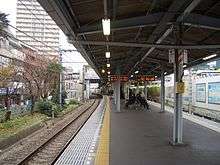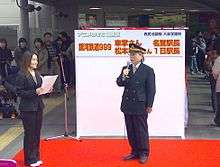Ōizumi-gakuen Station
Ōizumi-gakuen Station (大泉学園駅, Ōizumi-gakuen-eki) is a railway station on the Seibu Ikebukuro Line in Nerima, Tokyo, Japan, operated by the private railway operator Seibu Railway.
SI11 Ōizumi-gakuen Station 大泉学園駅 | |
|---|---|
North entrance, February 2007 | |
| Location | 1-29-7 Higashi-oizumi, Nerima, Tokyo (東京都練馬区東大泉1-29-7) Japan |
| Operated by | Seibu Railway |
| Line(s) | Seibu Ikebukuro Line |
| Other information | |
| Station code | SI11 |
| History | |
| Opened | 1924 |
| Previous names | Higashi-Ōizumi (until 1933) |
| Traffic | |
| Passengers (FY2013) | 84,006 daily |
Lines
Ōizumi-gakuen Station is served by the Seibu Ikebukuro Line from Ikebukuro in Tokyo, with some services inter-running via the Tokyo Metro Yurakucho Line to Shin-Kiba and the Tokyo Metro Fukutoshin Line to Shibuya and onward via the Tokyu Toyoko Line and Minato Mirai Line to Motomachi-Chukagai. Located between Shakujii-kōen and Hōya, it is 12.5 km from the Ikebukuro terminus.[1]
Station layout

The station has one ground-level island platform, serving two tracks.[2]
The station is located close to the home of Leiji Matsumoto, the creator of the anime Galaxy Express 999, and includes a statue of the Conductor from the series. From 2009, the station departure melody was changed to the Galaxy Express 999 theme tune.[2]
Platforms
| 1 | ■ Seibu Ikebukuro Line | for Nerima and Ikebukuro Tokyu Toyoko Line for Yokohama Minatomirai Line for Motomachi-Chukagai |
| 2 | ■ Seibu Ikebukuro Line | for Tokorozawa and Hannō |
Adjacent stations
| ← | Service | → | ||
|---|---|---|---|---|
| Seibu Ikebukuro Line | ||||
| Limited express: Does not stop at this station | ||||
| Rapid express: Does not stop at this station | ||||
| Express: Does not stop at this station | ||||
| Rapid: Does not stop at this station | ||||
| Shakujii-kōen | Commuter express | Hōya | ||
| Nerima | Commuter semi express | Hōya | ||
| Shakujii-kōen | Semi express | Hōya | ||
| Shakujii-kōen | Local | Hōya | ||
History

The station first opened on November 1, 1924, as Higashi-Ōizumi Station (東大泉駅), and was renamed Ōizumi-gakuen Station on March 1, 1933.[1]
Station numbering was introduced on all Seibu Railway lines during fiscal 2012, with Ōizumi-gakuen Station becoming "SI11".[3]
Through-running to and from Yokohama and Motomachi-Chukagai via the Tokyu Toyoko Line and Minatomirai Line commenced on 16 March 2013.[4]
Passenger statistics
In fiscal 2013, the station was the 8th busiest on the Seibu network with an average of 84,006 passengers daily.[5]
The passenger figures for previous years are as shown below.
| Fiscal year | Daily average |
|---|---|
| 2000 | 75,570[1] |
| 2009 | 84,089[6] |
| 2010 | 83,002[7] |
| 2011 | 81,725[8] |
| 2012 | 82,786[5] |
| 2013 | 84,006[5] |
Surrounding area
- Ōizumi Gakuen Yumeria Hall, Shop, and Tower
- Toei Tokyo Film & Animation Studios
- High School Ōizumi (associated with Tokyo Gakugei University)
- Ōizumi Metropolitan High School
References
- Terada, Hirokazu (July 2002). データブック日本の私鉄 [Databook: Japan's Private Railways]. Japan: Neko Publishing. p. 201. ISBN 4-87366-874-3.
- Kawashima, Ryozo (March 2011). 日本の鉄道 中部ライン 全線・全駅・全配線 第12巻 東京都心北部 [Railways of Japan - Chubu Line - Lines/Stations/Track plans - Vol 12 Northern Central Tokyo]. Japan: Kodansha. p. 33/63. ISBN 978-4-06-270072-6.
- 西武線全駅で駅ナンバリングを導入します [Station numbering to be introduced at all Seibu stations] (PDF). News Release (in Japanese). Japan: Seibu Railway. 23 February 2012. Retrieved 10 February 2013.
- 東急東横線・メトロ副都心線相互直通、16日スタート [Tokyu Toyoko Line and Tokyo Metro Fukutoshin Line inter-running to start on 16 March]. Nikkei.com (in Japanese). Japan: Nikkei Inc. 15 March 2013. Retrieved 2 April 2013.
- 駅別乗降人員 2013(平成25)年度 1日平均 [Average daily station usage figures (fiscal 2013)] (PDF) (in Japanese). Japan: Seibu Railway. Retrieved 22 June 2014.
- 駅別乗降人員 2010(平成22)年度 1日平均 [Average daily station usage figures (fiscal 2010)] (PDF) (in Japanese). Japan: Seibu Railway. Retrieved 26 January 2013.
- 各駅の乗車人員 (2010年度) [Station passenger figures (Fiscal 2010)] (in Japanese). Japan: East Japan Railway Company. Retrieved 26 January 2013.
- 駅別乗降人員 2011(平成23)年度 1日平均 [Average daily station usage figures (fiscal 2011)] (PDF) (in Japanese). Japan: Seibu Railway. Retrieved 26 January 2013.
External links
| Wikimedia Commons has media related to Ōizumi-gakuen Station. |
- Ōizumi-gakuen Station information (Seibu Railway) (in Japanese)